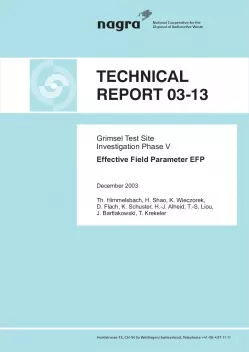
Technical Report NTB 03-13
Grimsel Test SiteInvestigation Phase VEffective Field Parameter FEP
Prediction modelling of groundwater flow and solute transport is an indispensable prerequisite for any long-term safety analysis concerning radioactive waste disposal in deep geological formations. This requires extensive geological and hydraulic information, a powerful numerical model, and the definition of effective parameter sets for the model.
The objectives of the EFP-project (Effective Field Parameter) are to examine methods for characterising the rock mass and for developing a structural model, to check the numerical model for calculation of the temporal and spatial distribution of tracer concentration on a large-scale, and to validate the developed model using in-situ data from large-scale tracer experiments at the Grimsel Test Site (GTS).
The main working programs of EFP include:
- geological and geophysical seismic investigation of two new boreholes EFP19 and EFP20,
- geostatistical re-evaluation of fracture data and structural model building,
- geophysical tomographic measurement combined with tracer experiment,
- large-scale ‘up-scaling’ tracer experiment, and
- numerical modelling.
Generally, the investigation results indicate that only a combined modelling strategy under consideration of deterministic and stochastic distribution of effective parameters and a correspondingly numerical code will allow to perform large-scale predictive modelling. However, the effective parameters, which were evaluated from the small and intermediate scale, should be up-scaled on the spatial variance and correlation length for the large-scale modelling. Non-linear adsorption and desorption dynamics combined with chemical reaction may become important in the near field, whereas, in the far field the matrix diffusion and the KD concept will ensure, due to generally low concentration levels, a sufficient prediction capability.
